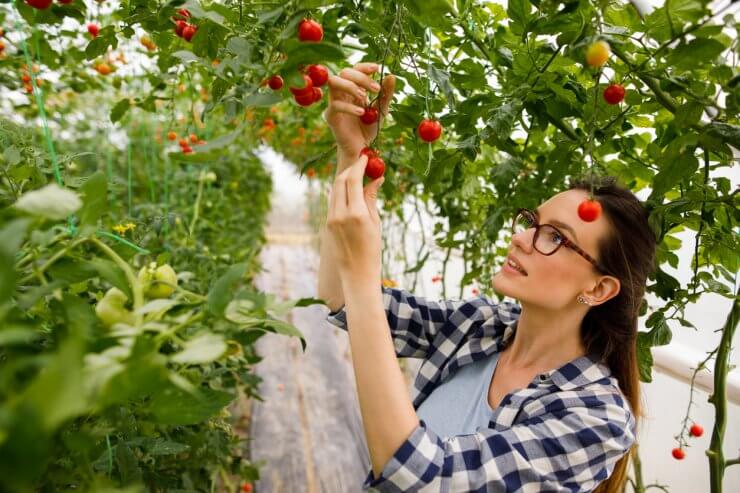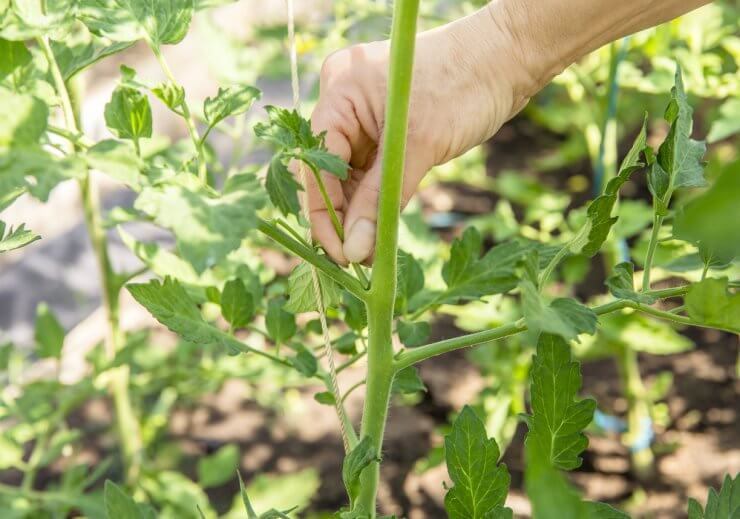One of the fun things about tomatoes is that you can harvest them before they’re actually ripe; those are the green tomatoes that you so commonly see in southern cuisine, battered in cornmeal and fried, or pickled, or even turned into salsa. Every tomato starts off green and then ripens to its intended color like red, yellow, orange, and sometimes even green, like Green Zebra.
When you do go to pick your perfect tomato, don’t just yank it off the plant; that may damage the plant and could jeopardize future ripe fruit. Use a knife or garden scissors to make a clean cut, separating the stem of the fruit from the plant. If you harvest some of your tomatoes, your plants will keep producing flowers to set more fruit, so pick away!

Tomatoes being harvested
If you have frost in the forecast and your tomato plants are in the ground or in raised beds, pick any tomatoes that look remotely ripe, then protect the remaining plants with a row cover. Row covers can increase the heat around your plants and protect them until the temperature drops below 25 degrees F; then growing season is definitely over.
Tomatoes can stay fresh on the counter for a week or so, and green tomatoes can be placed on the counter upside down for a few weeks until they ripen. They’ll ripen fastest in a warm room, and slower in a cold room.
Harvesting Green Tomatoes
As mentioned above, green tomatoes can turn ripe in a couple of weeks if you bring them inside and leave them on a windowsill or countertop.
Eating hard green tomatoes isn’t the best idea. All nightshades, like tomatoes, eggplants, and peppers, contain solanine. You probably already know not to eat green potatoes because of this alkaloid, but most seem to avoid the subject when it comes to tomatoes.
Solanine is one of the ways nightshades protect themselves and attempt to keep from being eaten. As tomatoes grow from green to red, the levels of solanine reduce almost completely.
There are two major toxic alkaloids in tomatoes—solanine and tomatine. Solanine (the most potent toxin) is in the fruit, while tomatine (less potent) is in the leaves and stems.
The good news is that even if you eat a hard-as-a-rock green tomato, you’ll probably survive. You may not even get a bellyache—but you might. The thing about toxins is that they accumulate in your body and take time to flush out. So if you were busy having fried green tomato parties every afternoon for lunch, you might notice symptoms, but it would still matter just how unripe the tomatoes are. Or if you already have arthritis or another type of inflammation, you may also notice it more than, say, a spry teenager.
How can you tell if a green tomato shouldn’t be eaten? Well, is it hard? Is it bitter? If so, it’s probably high in the poisonous alkaloid solanine. Is it turning yellow or red? If so, it will have a considerably lower concentration. Chefs that make fried green tomatoes aren’t using the hard green tomatoes or they’d taste terrible, they’re using ones that are just starting to turn.
You might also wonder when you can eat green varieties like Green Zebra (my favorite) or Limetto. The good news is that just like red tomatoes, they’ll be tender to the touch when they’re ready.
Pruning Tomato Plants
The most important thing you need to know about how to prune tomato plants is how to identify the “suckers.” These are the branches of your tomato plant that can either drain energy when left to grow, or give it to the tomatoes when they’re trimmed off.
To find the suckers, look at your tomato plant. You have the main stem, and then you have a regular branch. At the axis between the stem and branch, an extra branch often pops up, which is called a sucker. These are easiest to identify when the plant is still young. If you let them grow, they’ll just grow flowers and tomatoes, so they’re not a danger. But if you prune them off, your plant will have better aeration and will grow bigger and better tomatoes on the rest of the plant.

Early Pruning:
Ideally, prune early in the season, before the plants start getting unruly, when you can easily find the suckers and differentiate them from the central stalk.
- Use garden clippers to trim off the bottom branches from the lower 6 inches to avoid disease from the soil from getting onto the leaves, and also to give you room if you’re companion planting, such as planting basil around your tomato plants.
- Determinate tomatoes (those with a limited growth size and production season) will generally be topped with flowers or flower buds. You can lop the suckers off, anywhere below the first bud you see, and this will help with aeration.
- Indeterminate tomatoes (those that produce throughout the season and can grow for many months in warmer climates) have a longer season and really don’t need to be pruned to start. However, if you choose to prune indeterminate tomatoes, all you need to do is find the suckers and remove any that don’t seem beneficial, like those at the base, or those that are making the plant too bushy to aerate.
Mid-Pruning:
- If your tomato is unruly, and you have an indeterminate tomato, you can still clean up by removing suckers. (Don’t prune unruly determinate tomatoes once they start producing.) However, since they’re larger and well-grown now, you’ll have to be more careful not to lop off any tomatoes. Do this when you’re not expecting rain, and in the morning when it’s sunny so that the cuts will dry up quickly without letting in disease.
- Like in early pruning, you can clip off any stems with leaves touching the ground or those that are growing out of control by pruning them right at the main stem.
- You can get pretty aggressive with pruning indeterminate tomatoes, just leave any stems that already have tomatoes growing.
Late Pruning:
- When the season is nearing its end, prune the tops of your indeterminate tomato plants. Doing this will stop them from growing and creating new tomatoes so that they start producing bigger tomatoes on the bottom branches before the plant dies.
Done correctly (aka not killing them) pruning will give you bigger, better tomatoes. If you’re wondering how to prune tomato plants for maximum yield, follow the tips above.
But first, if you’re pruning multiple plants, make sure to clean your pruning shears with alcohol in between, so that you don’t spread any disease from one plant to another!
When do you harvest your tomatoes? Do you wait until they’re perfectly ripe or let them ripen on the counter?


 Previous
Previous


question: why did my Early Girl tomato plants get over 7ft tall this year – I know one was over 8ft tall. I caged them and staked them- they out grew both – they produced really well- but were needing attention practically everyday to control the upright position????????♀️